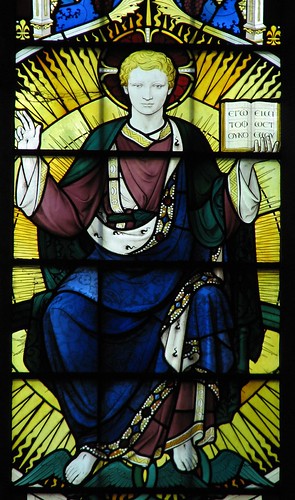Monday, June 18
From Of the Atmosphere of a Church, 1947

"To enter therefore a Christian church is to enter none other than the House of God and the Gate of Heaven. It is to leave all strife, all disputes [...] outside -- 'Thou shalt keep them secretly in Thy tabernacle from the strife of tongues'--and to enter here on earth into the Unity of the Church Triumphant in Heaven. It cannot be otherwise, since He Himself, who is the Temple of it, the Lamb slain from the foundation of the world, is there also. [...]
"It must, moreover, reduce to folly those terms of 'self-expression' and 'the expression of the age,' used to cover what is merely such incapacity and ugliness as every age has rejected. [...] The purpose of a church is [...] to move to worship, to bring a man to his knees, to refresh his soul in a weary land. That would seem to be the Creator's purpose towards man in giving him the beauty of nature, and it should be the purpose of all art. In art man partakes in this purpose of his Maker and objectively he brings the best of all He has given him to create beauty (in liturgy, poetry, music, ceremonial, architecture, sculpture and painting) to be the expression of his worship. For mankind in the mass the neglect of beauty spells the hardness and narrowness either of a puritan or of a materialist; though the saint and the mystic may pass directly, without the aid of external beauty of art, and even of nature, to God Himself.
"The note of a church should be, not that of novelty, but of eternity. Like the Liturgy celebrated within, the measure of its greatness will be the measure in which it succeeds in eliminating time and producing the atmosphere of heavenly worship. This is the characteristic if the earliest art of the Church, in liturgy in architecture, and in plastic decoration, and it is the tradition of all subsequent ages. The Church took over what is eternal in the Jewish and Greek temples, adapting and perfecting it to her use, developing and adding to it in unbroken sequence, and evolving new forms, some of which came to stay, and some of which needed correction. For the religion of Christ knows no moment of perfection here on earth, although it retains all perfections to which man has attained and rejects all imperfections of barbaric or evil days. It should have no use for the incapacities and crudities of primitive society in the invitation of which some have taken refuge today, this is rather a time to look into the rock whence we are hewn, respondere natalibus. While we cling to every loveliest form that man's work has produced just as we cling to every loveliestr flower of nature, we must again make the architecture of our churches in complete harmony with the Liturgy, as Rome has done so notably of late for its music. [This is clearly a reference to Pius X's motu proprio in promotion of chant--yet perceptively, Comper also sees both the benefits and the flaws that flowed from this sometimes-overrated ruling:] And yet, again, just as no moment is perfect, so no reform is pefect, for it will always go a little too far. The admission of later music and a stringed orchestra for the ordinary of the Mass at Barcelona on Easter Day, 1935, in addition to the unaccompanied plainsong and contrapuntal music, was no contradiction of the new ruling. For is there no room in the Kingdom of Eternity here for all manner of music that it has entered into the heart of man to conceive as existing there?
"And so it should be with architecture, the other handmaid of liturgy. No beautiful style should be excluded. But the plan, the 'layout' of the church must first be in accord with the requirements of the liturgy. [...] There is no need to apologise for doing so in architecture [...]
"And do we want originality? I quote Dr. Inge: 'What we call originality is generally the power to see old things in a new light--it is the reading of some open secret, as we know it to be in the natural Sciences.' [...]
~Sir Ninian Comper (1864-1960)












